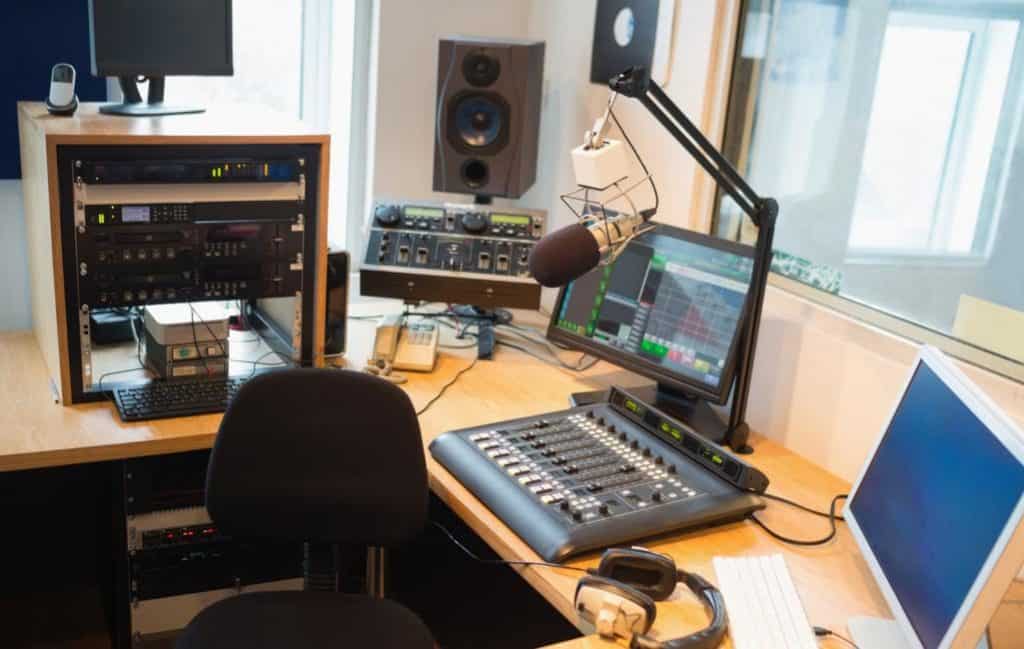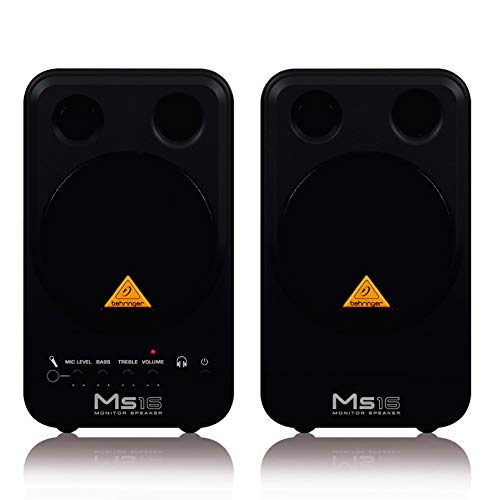As an Amazon Associate we earn from qualifying purchases.
Studio monitors are essential for every musician and record composer. Large commercial recording studios need to set a high budget for studio monitors. However, if are hobbyists who want to mix and master your own music, you don’t have to spend a large sum on the equipment.
In this blog post, you will learn what factors to consider when buying a cheap studio monitor for music composition. To make the task easier for you, we have picked six cheapest studio monitor speakers that offer solid audio performance suitable for mixing and recording your music.
Table of Contents
- 1 Things to Consider to Buy the Best Cheapest Studio Monitor Speakers
- 2 1. JBL Professional LSR305
- 3 Key Features
- 4 2. Mackie CR3 Studio Monitors
- 5 Key Features
- 6 3. Edifier R1280T Powered Speakers
- 7 Key Features
- 8 4. PreSonus Eris E3.5
- 9 Key Features
- 10 5. Behringer MS16
- 11 Key Features
- 12 6. Rockville DPM8
- 13 Key Features
- 14 Can I Use Speakers Instead of Studio Monitors?
Things to Consider to Buy the Best Cheapest Studio Monitor Speakers
Buying a studio monitor is not as simple as selecting a regular speaker. You should consider many different factors to ensure that you don’t waste money on a substandard studio monitor.
1. Frequency Range
One of the foremost things to consider is the frequency range that the monitors can handle. The lowest frequency range that the monitors can handle is the hertz (Hz) and the highest frequency range in kilohertz (kHz). Consider selecting studio monitors with a frequency response range between 50 Hz and 20 kHz. The higher the frequency response range, the better the studio processing quality.
2. Frequency Variation
Another important aspect that you need to consider is the variation in the frequency response rate that is measured in decibels. Consider studio monitors with a variation of no more than + 3 dB. Monitor speakers with a higher variation in frequency range will produce some frequencies that will be softer or louder as compared to others.
3. Powered or Unpowered Speakers
Powered speakers are generally suitable for most home studios. Also known as active speakers, these studio monitors have a built-in amplifier. As a result, you don’t have to buy a separate amplifier. Some of the powered speakers are bi-amplified with each speaker having a separate power amp that can handle different frequency ranges.
Unpowered speakers are also known as passive speakers. You should select this option only if you already have an external amplifier. Moreover, you can buy these speakers if you want to create multi-speaker arrays. These speakers generally have a crossover circuitry that allows you to split high and low frequencies.
4. Subwoofer
Do you process music with high bass such as electro or hip-hop? If yes, you must also buy a studio subwoofer that can handle low frequencies (30 Hz or lower). A subwoofer is also recommended for processing of surround sound music.
5. Total Harmonic Distortion
Total harmonic distortion (THD) represents the sound reproduction accuracy of studio monitors. In other words, THD shows how much noise you can expect with studio monitors. The lower the figure, the better is the quality of the studio monitor. Ideally, you should look for studio monitors with TLD of less than 0.001%.
6. Inputs
Studio monitors come in different jacks including 3.5mm TRS, 1/4’’ TRS, RCA, XLR, or S/PDIF. Make sure that the studio monitors can connect with your musical equipment. Some monitors come with all the jacks while others only support only certain jack input. You may end up wasting money if the studio monitors don’t support your equipment.
7. Sound Pressure Levels
Sound pressure levels measured in decibels (dB) is also an important consideration when buying studio monitors. The term measures speaker sensitivity. It refers to the number of decibels of sound pressure level per amplifier wattage measured about one meter from the speaker.
The best studio monitors have peak SPL in the range of 85 to 91 dB. Avoid buying studio monitors with SPL less than 85 as they are not good for processing and mixing sound.
8. Near-, Mid- or Far-Field Studio Monitors
Near-field studio monitors are suitable for most small home studios. You should not buy mid- or far-field monitors unless your rooms are specially treated to minimize reverberations and echo. For most purposes, near-field monitors are adequate.
Now that you know how to select the best studio monitors, let’s look at the cheapest studio monitor speakers you can buy for recording and mastering music.
1. JBL Professional LSR305
JBL LSR305 is one of the cheapest studio monitors that offer great value for money. The bi-amplified 2-way studio monitors have an excellent SPL and frequency range making it great for most beginner musicians. Moreover, the powered studio monitors come with magnetically shielded low and high-frequency transducer, input-sensitivity switch and volume control. You will experience great ambiance and depth in recordings even in dense mix.
Key Features
- Brand Name: JBL
- Item Model Number: LSR305
- Frequency Response Range: 43 Hz – 24 kHz
- Maximum SPL: 108 dB
- Inputs: XLR, TRS
2. Mackie CR3 Studio Monitors
Mackie CR3 is another good quality cheap studio monitors that can reproduce sound with a high degree of accuracy. The monitors have one powered active speaker and one unpowered passive speaker. You can select a speaker using a switch. There is also a dedicated headphone jack that increases the versatility of the speakers in monitoring sound. Overall, the studio monitors also provide great value for money.
Key Features
- Brand Name: Mackie
- Item Model Number: CR3
- Frequency Response: 80 Hz – 20 kHz
- Maximum SPL: 97 dB
- Input: 1/4” TRS, RCA, 3.5mm TRS
3. Edifier R1280T Powered Speakers
Edifier R1208T look sleek and stylish that can add to the ambiance of a recording studio. The monitors have a retro look with wooden panels. One of the studio speakers is active speaker while the other is passive speaker. The speaker can reproduce adequate quality sound that is worth it for the price. You also have the option to adjust the bass level to suit your requirements.
Key Features
- Brand Name: Edifier
- Item Model Number: R1280T
- Frequency Response: 40 Hz – 14.25 kHz
- Maximum SPL: 85 dB
- Inputs: 2x Aux, RCA
4. PreSonus Eris E3.5
PreSonus Eris 3.5 is one of the best affordable studio monitors that can meet the need for small studios. The monitors have a high SPL and can handle a range of frequencies that is suitable for most beginner musicians. These monitors have Kevlar drivers that allow them to produce low-frequency sound without any distortion.
Key Features
- Brand Name: PreSonus
- Item Model Number: Eris 3.5
- Frequency Response: 80 Hz – 20 kHz
- Maximum SPL: 100 dB
- Inputs: 1x 1/4” TRS, 1x 1/8” TRS, 2x RCA
5. Behringer MS16
Behringer MS16 may not be great for professional musicians but it does deliver great performance for its price. The studio monitors can reproduce accurate sound from a range of musical instruments revealing subtleties within the music. The monitors are ideally suited for small studios, vocal monitoring, and home multimedia applications.
Key Features
- Brand Name: Behringer
- Item Model Number: MS16
- Frequency Response: 80 Hz – 20 kHz
- Maximum SPL: 85 – 90 dB
- Inputs: 1/4” TRS, 1/8” TRS, RCA
6. Rockville DPM8
One of the highlights of the Rockville DPM8B is handling of frequency as low as 30 Hz. In addition, the quality MDF enclosure allows the studio monitors to accurately reproduce a range of sounds. The studio monitors allow distortion-free listening even at maximum volume.
Key Features
- Brand Name: Rockville
- Item Model Number: DPM8B
- Frequency Response: 30 Hz – 20 kHz
- Maximum SPL: 106 dB
- Inputs: 1/4” TRS, XLR, RCA
Can I Use Speakers Instead of Studio Monitors?
A lot of you might be wondering whether you can buy a cheap powered speaker instead of studio monitors. The answer is that regular speakers are not intended for music processing. Regular powered speakers are intended to make the sound appear pleasing. They enhance the quality of sound through rich bass and high frequencies.
In contrast, studio speakers reproduce sound at a flat frequency without any kind of modification. The monitors accurately reproduce the sound without enhancing the sound quality. This is important for professional recording and editing of music.
Remember that you get what you pay for. The cheapest studio monitor speakers listed in this article are great for hobbyists as well as small recording studios. However, professionals and large studios should set a higher budget for studio monitors. Consider buying studio monitor isolation pads for authentic reproduction of music.
Amazon and the Amazon logo are trademarks of Amazon.com, Inc, or its affiliates.






